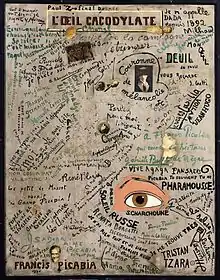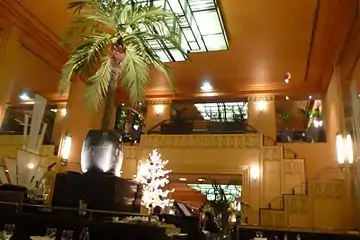Le Boeuf sur le Toit (cabaret)
Le Boeuf sur le Toit (The Ox on the Roof) is the name of a celebrated Parisian cabaret-bar, founded in 1921 by Louis Moysés which was originally located at 28, rue Boissy d'Anglas in the 8th arrondissement of Paris. It was notably the gathering place for the avant garde arts scene during the period between the wars. Maurice Sachs chronicled it in his 1939 book Au temps du boeuf sur le toit (Paris: Nouvelle Revue critique, 1948).[1] Currently it is at 34, rue du Colisée, having moved five times within the 8th arrondissement. The current building dates from the 18th century.
Origin of Le Boeuf
The composer Darius Milhaud had been in Brazil where he had been impressed by the folklore and a popular song of the time, O Boi no Telhado (The ox on the roof). Back in Paris in 1919 Milhaud and his composer friends formed a group called Les Six. The poet Jean Cocteau was an informal member of the group and later would do the choreography for Milhaud's composition Le bœuf sur le toit—a direct translation of the Brazilian song name. This ballet farce became very popular and Milhaud, joined by Georges Auric, and Arthur Rubinstein could often be heard playing a six-handed version of it at La gaya, a bar at 17, rue Duphot owned by Louis Moysès.[2] The presence of Cocteau and his circle made the Gaya very popular and in December 1921, when Moysès moved his bar to rue Boissy d’Anglas, he named the new bar Le Boeuf sur le Toit, probably to be sure that Milhaud, Cocteau, and their friends went with him.[1][3] They did—and Le Boeuf was born. Over the years the bar became such an icon that the common belief in Paris was that Milhaud's ballet-farce had been named after the bar, which was the opposite of what actually happened.[4]
History
Le Boeuf sur le Toit was a success from the day it opened.[5] It quickly became the center of Paris cabaret society and reigned throughout the twenties.[4][6] On opening night pianist Jean Wiéner, who Moysès had brought with him from the Gaya, played Gershwin tunes with Cocteau and Milhaud providing accompaniment on the drums. According to Maurice Sachs, the opening night audience included Pablo Picasso, René Clair, Sergei Diaghilev and Maurice Chevalier.[7]

Artists of all kinds came to Le Boeuf. On the wall, reigning over the scene, was Francis Picabia's now famous Dada work L’Oeil Cacodylate (The Cacodylic Eye).[8] But the bar was mainly about music. One could hear Jean Wiéner playing Bach, virtuoso pianist Clément Doucet playing Cole Porter, or Marianne Oswald singing the songs of Kurt Weill. You could run into Stravinsky, Francis Poulenc, Catherine Sauvage, or Erik Satie.[1] Frequent guests also included the young American composer Virgil Thomson and other classical musicians from Le Six.[9][10][11][12] Jazz musicians from other Paris clubs would show up at Le Boeuf after hours and play long into the night—for Paris was above all the city of jazz.[6] In France, the expression "faire un Boeuf" is used by musicians to this day to mean "to have a jam session" and derives from the name of this cabaret.[4]
In 1928, owner Louis Moysés was forced to move to a new location, and this was followed by more moves, always within the 8th arrondissement.[13]
- In 1922 Le Boeuf sur le Toit founded at 28 rue Boissy d'Anglas
- In 1928 moved to 33, rue Boissy d'Anglas
- In 1928 moved again to 26 rue de Penthièvre
- In 1936 moved to 41 bis avenue Pierre 1er de Serbie
- In 1941 moved to 34, de la rue du Colisée

The many relocations proved ruinous to the effervescent spirit of the original cabaret. Le Boeuf sur le Toit exists as a chic restaurant to this day.[14] But the glamour, social cachet, avant-garde milieu, and bohemian atmosphere—they are a distant memory.[4]
Kristallnacht
In 1938 Nazi propagandists reacted furiously to the assassination of German diplomat Ernst vom Rath by Herschel Grynszpan, a young Jewish man; and this was used as a pretext for Kristallnacht. But according to historian Hans-Jürgen Döscher, the shooting was not politically motivated, as commonly believed, but the result of a homosexual love affair gone wrong. Döscher claimed that Grynszpan and Vom Rath had become intimate after they met in Le Boeuf sur le Toit, which was a popular hangout for gay men at the time.[15]
Famous patrons of and performers at Le Boeuf sur le Toit
From the day it opened, Le Boeuf was the epicenter of the Paris of the Roaring Twenties and was always thronged by the beau monde and the cream of the avant-garde. People likely to be seen at Le Boeuf included:[1][2][3][6]
- Louis Aragon
- Georges Auric
- Marcel Aymé
- Josephine Baker
- Barbette
- Jane Bathori
- Tristan Bernard
- Paul Bourget
- Constantin Brâncuși
- Georges Braque
- André Breton
- Albert Camus
- Georges Carpentier
- Blaise Cendrars
- Coco Chanel
- Charlie Chaplin
- Maurice Chevalier
- René Clair
- Paul Claudel
- Jean Cocteau
- Henri Collet
- André Derain
- Sergei Diaghilev
- Clément Doucet
- Louis Durey
- Léon-Paul Fargue
- Léo Ferré (after World War II)
- André Gide
- Ernest Hemingway
- Arthur Honegger
- Max Jacob
- Marcel Jouhandeau
- Frida Kahlo
- Marie Laurencin
- Darius Milhaud
- Paul Morand
- Mistinguett
- Marianne Oswald
- Francis Picabia
- Pablo Picasso
- Francis Poulenc
- Jacques Prévert
- Yvonne Printemps
- Raymond Radiguet
- Maurice Ravel
- Pierre Reverdy
- Alfonso Reyes
- Arthur Rubinstein
- Erik Satie
- Catherine Sauvage
- Igor Stravinsky
- Germaine Tailleferre
- Virgil Thomson[16][10][17][12]
- Tristan Tzara
- Jean Wiéner
References
- Notes
- The Boeuf chronicles: Maurice Sachs by Laurent Gloaguen, 24 July 2004
- "Cafe Music", Time, 26 October 1931.
- Richardson, p. 209.
- The Boeuf chronicles: How the Ox got its name, and other Parisian legends, by Daniella Thompson, 6 May 2002
- Lisa Appignanesi (1984). Cabaret: The First Hundred Years. London: Methuen. p. 104. ISBN 041353880X.
- Appignanesi, p. 123.
- "Paris in the twenties" Archived 8 October 2011 at the Wayback Machine, The Globe Weekly News.
- The Boeuf chronicles: The bar-restaurant, by Daniella Thompson, 4 August 2003.
- Virgil Thomson Virgil Thomson. Library of America & Penguin Random House. New York. 2016 ISBN 978-1-59853-476-4 p. 135-136 Virgil Thomson and Le Boeuf sur le Toit on http://books.google.com
- The Rest is Noise – Listening to the twentieth Century Alex Ross. Picador, New York 2007 ISBN 978-0-312-42771-9 p. 110 Virgil Thomas describes Le Boeuf sur le Toit on http://books.google.com
- Encyclopedia of Music in the 20th Century Editors – Lee Stacey & Lol Henderson. Routledge, New York 2013 p. 631 Virgil Thomson on http://books.google.com
- Prepare for Saints – Gertrude Stein, Virgil Thomson, and the Mainstreaming of American Modernism Steven Watson, Random House, New York 1998 ISBN 978-0-307-82273-4 Le Boeuf sur le Toit and Virgil Thomson and Le Six on google.books.com
- In the spotlight Archived 27 August 2011 at the Wayback Machine, Le Boeuf sur le Toit, Official website.
- Boeuf sur le Toit Brasserie In Paris
- Did gay affair provide a catalyst for Kristallnacht? by Kate Connolly, The Guardian, 30 October 2001
"On 7 November 1938, Herschel Grynszpan, a Jew, walked into the German embassy in Paris and shot Ernst vom Rath, a German diplomat. Nazi propagandists condemned the shooting as a terrorist attack to further the cause of the Jewish 'world revolution' and launched the series of attacks known as Kristallnach. Vom Rath and Grynszpan met in Le Boeuf sur le Toit bar, a popular haunt for gay men in the autumn of 1938 and became intimate." - Virgil Thomson Virgil Thomson. Library of America & Penguin Random House. New York. 2016 ISBN 978-1-59853-476-4 p. 135-136 Virgil Thomson and Le Boeuf sur le Toit on http://books.google.com
- Encyclopedia of Music in the 20th Century Editors – Lee Stacey & Lol Henderson. Routledge, New York 2013 p. 631 Virgil Thomson on http://books.google
- Sources
- Appignanesi, Lisa, The Cabaret: The First Hundred Years, London: Studio Vista, 1975, ISBN 0-289-70612-2
- Sachs, Maurice, Au temps du boeuf sur le toit, Paris: Grasset, 2005, ISBN 2-246-38822-8
- Richardson, John & McCully, Marilyn, A Life of Picasso: The Triumphant Years, 1917–1932, New York: Alfred A. Knopf, 2007, ISBN 0-375-71151-1
External links
| Wikimedia Commons has media related to Le Bœuf sur le toit. |